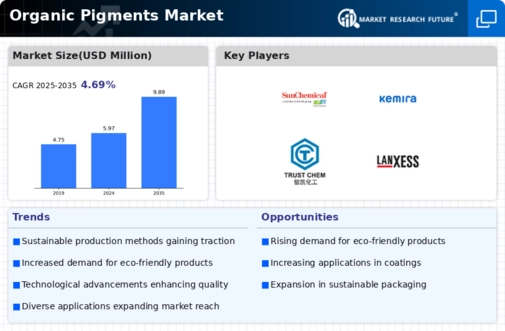Top Industry Leaders in the Organic Pigments Market
 This industry, catering to the insatiable demand for vibrant hues in various applications like paints, plastics, and printing inks, is a dynamic battleground where established players and rising stars vie for market share. Let's delve into the intricate tapestry of this market, exploring the strategies driving success, the factors influencing market share, and the latest developments shaping its future.
This industry, catering to the insatiable demand for vibrant hues in various applications like paints, plastics, and printing inks, is a dynamic battleground where established players and rising stars vie for market share. Let's delve into the intricate tapestry of this market, exploring the strategies driving success, the factors influencing market share, and the latest developments shaping its future.
Strategies Adopted by Market Leaders:
-
Innovation: Leading players like BASF and Clariant prioritize research and development, constantly innovating with new pigments offering superior performance, brightness, and environmental friendliness. BASF's Xfast® Easy Color, a user-friendly organic pigment for coatings, exemplifies this approach. -
Diversification: Market leaders are expanding their portfolios beyond traditional applications. Sun Chemical, for example, has entered the high-growth market of organic pigments for 3D printing materials. -
Sustainability: Environmental consciousness is driving the demand for eco-friendly pigments. Companies like Lanxess are actively developing new pigments with lower environmental impact, such as their X-Pigments line. -
Acquisitions and Partnerships: Mergers and acquisitions are a common strategy for market expansion. In 2021, DIC Corporation acquired BASF's pigments business, strengthening its position in Asia. Partnerships with raw material suppliers and distributors also play a crucial role.
Factors Influencing Market Share:
-
Geographical Distribution: The Asia-Pacific region, particularly China, dominates the market due to its booming construction and manufacturing sectors. Europe and North America, however, hold significant shares due to their advanced technologies and stringent environmental regulations. -
Pricing: The higher cost of organic pigments compared to inorganic alternatives makes pricing a critical factor. Efficient production processes and cost-effective sourcing of raw materials are crucial for competitive pricing. -
Application Diversification: Paints and coatings currently consume the largest share of organic pigments, but the growing demand from plastics, printing inks, and other industries is diversifying the market. Companies catering to these emerging sectors gain an edge. -
Regulatory Landscape: Stringent regulations on the use of certain pigments, like azo pigments, are impacting the market. Companies that develop compliant and safe pigments stand to benefit.
Key Companies in the Organic Pigments market include
-
Dainichiseika Color & Chemicals Mfg. Co. LtdBASF SE
-
Synthesia AS
-
Trust Chem Co. Ltd
-
Sudarshan Chemical Industries Limited
-
DIC Corporation
-
Toyocolor Co. Ltd
-
Changzhou Longyu Pigment Chemical Co. Ltd
-
Ferro Corporation
Recent Developments:
-
October 2023: Lanxess launches a new series of organic pigments with improved lightfastness and durability, targeting the outdoor coatings market. -
November 2023: BASF and Sun Chemical partner to develop new sustainable organic pigments using renewable raw materials. -
December 2023: The Chinese government announces plans to invest in research and development of high-performance organic pigments, aiming to reduce reliance on imports. -
January 2024: Clariant acquires a leading manufacturer of organic pigments in North America, expanding its geographic reach and product portfolio.

